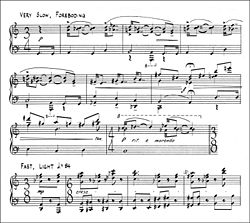Music engraving

Music engraving is the art of drawing music notation at high quality.
This term originally referred to plate engraving - the traditional process of engraving music directly onto a zinc or pewter plate in mirror image. Staff lines were created by dragging a 5-pronged "scoring tool" across the plate, thus the designation, "score" for printed music. Fixed symbols, like note heads and clefs, were punched into the metal with dies, and variable symbols, such as beams or slurs, were engraved by hand.
Plate engraving produced high-quality results, but was only one of several competing technologies in use for reproducing music. Others included:
- Moveable type with music symbols on - a centuries-old method, often used for hymn books, but which produced low-quality results
- Music typewriters - like moveable type, this produced low-quality results and was never widely used
- Hand copying with pen and ruler, which if done by an expert Music Copyist can produce high-quality results
- Notaset - dry transfer symbols similar to Letraset
- Brushing ink through stencils, a high-quality technique used by Amersham-based company Halstan & Co.
Because plate engraving was laborious and expensive, it became obsolete around 1990.
The term music engraving is now used to refer to any high-quality method of drawing music notation, particularly on computer ("computer engraving" or "computer setting") or by hand ("hand engraving"). There are numerous computer programs, known as scorewriters, designed for editing and printing music, though only a few produce results of a quality comparable to plate engraving.
The term music copying is almost equivalent, though "music engraving" implies a higher degree of skill and quality.
In the distant past, a composer was required to draw his own staff lines (staves) onto blank paper. Eventually, staff paper was manufactured pre-printed with staves as a labor-saving technique. The composer could then compose music directly onto the lines in pencil or ink.
In the 20th century, music staff paper was often printed onto vellum or onionskin: a durable, semi-transparent paper which made it easier for the composer to correct mistakes and revise his work, and also enabled copies of the manuscript to be reproduced through the ozalid process. Also at this time, a music copyist was often employed to hand-copy individual parts (for each musician) from a composer's musical score. Neatness, speed, and accuracy were desireable traits of a skilled copyist.
With the advent of the personal computer in the late 1980s and beyond, music manuscript has become a lost art, as all of the "drawing" of each note, symbol, staff, written instruction, etc., can now be accomplished by a graphics computer software made for this purpose, such as Finale. Even individual parts of an orchestral score can be extracted and printed with this method. MIDI software is also available, which enables the composer to play notes, melodies, chords, etc. on a piano-type keyboard and have the result transcribed into manuscript format.
References
- Ted Ross. Teach Yourself The Art of Music Engraving & Processing Hansen Books, Florida.
